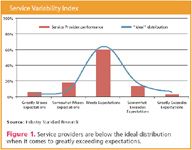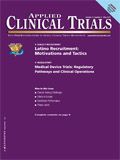What to Know About CROs
Applied Clinical Trials
Where do CRO's turn next? What does pharma do about it?
In case you have not noticed, there have been some massive changes in the pharma services industry over the past six months: mergers, acquisitions, more mergers, venture capital/ private equity buy-outs, capital infusions, and even more mergers. What not too long ago was a group of top 10 CROs has quickly been cut to six with inVentiv purchasing i3 Pharma Services and PharmaNet and INC Research purchasing Kendle. So now what do we talk about as an industry?

Chad J. Shaffer\Getty Images
My wise grandfather used to say "Great minds discuss ideas, ordinary minds discuss events, and simple minds discuss people." It was his way of reminding us that talking about people isn't overly productive. But what if your ideas are triggered by people or events? I think my grandfather would have gotten a kick out of trying to answer questions like that. Often the three are indistinguishable. It's hard to talk about an event without talking about the people involved. It's hard to talk about ideas without talking about those that had them first. This article focuses on all three elements of the saying my grandfather liked: ideas, events, and people. We will take each of these points in reverse order, starting with people.
People
What happens when an industry grows up together? We have obviously witnessed this before with the transition of the early PC/web/technology companies. Microsoft went through it when Bill Gates stepped aside and they, after a few hiccups, are doing just fine; Marc Andersen (Netscape) simply sailed off into the sunset and Netscape, as an entity, is no more; Larry Ellison is still actively at the helm of Oracle; and Apple needed Steve Jobs to come back and save them after he decided to pursue other interests. Needless to say, many a corporate strategy map was created, modified, scrapped, and redesigned during these periods. And while we weren't there in the trenches, we'd hazard a guess that the strategies of these companies depended on who was driving the company.
Focusing back on the CRO industry; what are the implications when the innovator CEO retires, become less engaged, gets bought out, or gets moved out? Does the company inevitably change direction? Does it recalculate on the fly or is the destination, the goal, already programmed into the corporate consciousness? It would be one thing to try and judge the potential impact on a single company if/when the founder moves on. It is quite another exercise to hypothesize how this could play out on an industry-wide scale. Most of the major players in the CRO industry were formed within six or seven years of each other. And this makes for a fairly homogenous group. Let's also not forget that the research tells us that most of these companies struggle to differentiate themselves, with personal/past relationships being perhaps the single most important driver of new and repeat business.

Figure 1
What makes this phenomenon more pronounced is that you have arguably the three largest clinical development service providers (Quintiles, PPD, and PAREXEL) still being run by their founder. PPD is included in this mix as Fred Eshelmen, PharmD, is still very active in the company. Remember that back in 2001 Dennis Gillings, PhD, Quintiles ceded the CEO position only to take it back after two years.
What you are starting to see is a dichotomy between new management and industry stalwarts. We've recently witnessed one of the long-timers, Candice Kendle's company, being acquired by INC Research and we've previously seen Eshlemen vacate the CEO role at PPD. The average tenure as CEO for the non-Founder CEOs is about five years while the average for the Founder CEOs is about 31 years.
This isn't good and it isn't bad. What we are proposing is that carefully monitoring how the inevitable transitions take place for INC Research, PAREXEL, maybe PPD again, and Quintiles will dramatically shape industry events in the coming years.
The next generation of CRO leadership will have to operate globally and be able to grow the core clinical development revenues while vertically integrating up and down the value chain in order to grow revenue and expand/hold margins.
Events
The CRO industry has been the place to watch if you are looking for meaningful events. You don't have to look far to find inVentiv's purchase of i3 Pharma services, Campbell Alliance, and PharmaNet; INC Research's sale to private equity and then their purchases of Avos Consulting, Kendle, and Trident; LabCorp's purchase of Clearstone Central Labs; and a host of corporate rebranding and restructuring. ISR believes this round of much needed CRO consolidation will likely continue. Consolidation will not simply be mergers of like organizations, but will be predicated on broadening their service offerings and geographical reach. The next set of companies to watch are PRA, Medpace, and BioClinica.
There are two ways to get from point A to point B: the direct route and the indirect route. ISR believes if you look into the future, the biopharma outsourcing industry is a growth industry. There will be more revenue generated five years from now than is being generated today. That said, we are not in the most stable of times for service providers. Global biopharma is reeling from patent expirations, ineffective pipelines, and adjusting to the seemingly endless parade of mergers themselves. All of this is having a significant impact on CROs. Want proof? Take a look at the recent financial volatility surrounding the publicly traded CROs. Over the past four quarters we have seen book-to-bill ratios between 0.20 and >2.00, we have seen cancellation rates as low as the mid-teens to over 50%, we have seen market capitalizations cut by 30% in a day.
Talk about recalculating a strategy or tactical operations, try and manage a corporation where swings like this are occurring. Keeping an eye on operational consistency, ISR's measure in its Service Variability Index (SVITM), will be vitally important to CROs as they grow and especially important for those going through recent mergers. The SVITM measures how well a service provider meets customer expectations on a variety of important service quality attributes.
The good news for CROs is that most biopharma companies are increasing their outsourcing activities; many in the form of large, multi-year strategic arrangements. Again, this creates wild swings in new business wins, revenue, and hopefully profit. The ups and downs of biopharmaceutical outsourcing can be summarized by looking at Pfizer's recent strategic decisions. Pfizer is shedding thousands of R&D jobs and is shaking up how it does research. The company is closing a research hub in Sandwich, UK, and moving some activities out of its Groton, CT R&D headquarters as it narrows the number of therapeutic areas it is working on. While these changes sound somewhat macro to most people, these changes have real and sometimes dramatic impacts on service providers. If you are a CRO that worked with Pfizer on one of the therapeutic areas they are no longer going to participate in, then this announcement could be fatal. On the other hand, if your company was lucky on two counts: to work with Pfizer and your therapeutic area is unaffected; you are still not out of the woods. Pfizer R&D is certainly in a period of turmoil causing delays in decision-making and budgeting, the inevitable game of human resource musical chairs has started, and most importantly, the process of compound prioritization and resource rationalization has begun. Only time will tell how successful CROs like PAREXEL and ICON are at navigating the ups and downs of Pfizer clinical development organizations.
So, while the tide might be rising for all CROs based on an increase in clinical development outsourcing, (longer strategic partnerships, pharma mergers, and sponsor internal R&D cuts) the activity has become a lot more volatile.
Clinical trials are long endeavors, often lasting two or three years (or more if you have long-term registry studies or strategic partnerships in place), which makes the effects of succession planning, strategic planning, and resources planning, or lack thereof, quite important. Biopharma sponsors don't make many short-term purchases from clinical development service providers. They can't simply change providers at the drop of a hat should things start to deteriorate. This is even more pronounced when thinking about the strategic partnerships sweeping the industry. Often these are multi-year deals come with sharing IT infrastructure, shared performance metrics, shared SOPs, and senior management governance and responsibility.
In the end, the business of clinical development outsourcing is about people and trust. All the mergers in the world can't impact a study as much as the quality of one project manager. How do we know? We ask pharma decision-makers what is important to them when they outsource a clinical development study. Do they tell us global reach? Not very often. Do they tell us innovative solutions? Sometimes. The one consistent thing they tell us is experience and expertise of the service provider's people.
As CROs become larger and global, project managers will work more autonomously within their own organization. While it has probably always been the case, ISR believes as CROs grow, their success or failure will depend more on micro, yes micro factors like individual project managers. Finding, hiring, training, and retaining high quality clinical project managers will be the keys to long-term CRO growth, profitability, and stability. The way to consistent delivery, low service variability, is to have high quality individuals running the studies.
Ideas
There are a few significant questions to ponder as a result of recent or highly anticipated industry events. ISR looks at potential changes to the outsourced clinical development industry by stratifying companies by size.
Small service providers. These companies can continue to stay the course and try to build their customer base through specialization (therapeutic, procedural, and expertise) and relationship building, probably targeting small/emerging biotech companies. If you can find a sister company that can add capabilities/capacity without much overlap, then growing by merger is a real potential. The goal is to reach a critical mass large enough to play in the mid-size pharma segment. These providers definitely serve a valuable purpose in the clinical development world as they often specialize in services that large-scale companies (CROs or Pharma) could not profitably provide.
Mid-size service providers. These companies are probably under some pressure, especially some of the larger ones that have been passed over in the recent merger activity. There are some obvious advantages to being a large, global, full-service service provider. This allows you to play in the sandbox with the large pharma customers, where clinical development activities are centralized. However, ISR's research shows that sponsors are generally more satisfied with mid-size CROs than they are with the traditional set of large CROs. So how do you grow, but maintain your service quality? Concentrating on organizational development strategies that focus on service delivery and constantly monitoring your service quality through a customer satisfaction program are two recommended approaches. There will be continued consolidation at this level. Whether this consolidation is through a merger of peers (PRA and Medpace) or though multi-mergers focusing on a technology or approach (Aptiv via Averion, Fulcrum Pharma, ClinResearch, ADDPLAN, Trio Clinical Resourcing, and Niphix) or therapeutic mergers (US Oncology and Ockham and MedSource), we see the trend continuing.
Large service providers. The playing field has suddenly become more crowded in the past 12 months. There are now more service providers that can legitimately call themselves large, global, and full-service. Over the next 12-24 months, companies like Quintiles, PAREXEL, PPD, and ICON (maybe especially ICON) will start to feel more pressure from the new kids on the block; large pharma RFPs and awards will now be split among a larger group. How do you differentiate yourself once size is no longer the same strategic asset it once was? Some have gone the way of tacking on consulting capabilities (Quintiles, INC Research, PAREXEL, and inVentiv). Some have tried the technology route (PAREXEL and Perceptive Informatics). Some have gone to integrated clinical and commercial capabilities (inVentiv, Quintiles).
ISR believes the next step in the evolution of large CROs will be the establishment of a category killer. Potential category killers could be:
- PAREXEL + Covance: PAREXEL is in need of a central lab and Covance gets more scale in its Phase II/III operations.
- PPD + ICON: geographical strengths make this a combination with less operational overlap than other large combinations.
- Quintiles + Accenture: gives Accenture a stronger operational arm and gives Quintiles access to the C-suite to effectively implement its joint clinical, commercial, and capital strategy.
Several companies could have been mixed-and-matched in this analysis and a myriad of technology plays could be throw, but the general point remains the same; the establishment of a category killer is a next logical step for the large CROs.
So what does it all mean to you? How do you prepare in the event your corporate or department or group navigation device starts blinking "recalculating?"
Biopharma companies. Develop programs that constantly measure your organization's internal satisfaction with your service providers.
Look to outside sources for independent assessments of service providers. There could be better/alternative options available to you (e.g., high quality service providers you don't have direct experience with).
Move to penalties or bonuses for CROs that retain their staff through an entire project.
Know your service providers. Ask, what has changed in the past six months that I need to know about? If they have gone through a recent merger ask about the make-up of the study team. For example, do you have a PM from inVentiv, a CTL from i3 Research, and a CRA corps from PharmaNet?
CROs
- Measure twice and cut once. Measure your customers' satisfaction with your operations and your people.
- Keep your strategic options open and keep abreast of your competition and how their actions affect your selling messages and business models.
- Invest in key personnel training and reward high customer service.
- Develop transparent systems. These systems will quickly alert senior management if there are issues and keep your customers aware of your activities.
- Prepare internal infrastructure, systems, and processes for increased accountability (e.g., bonus/penalty clauses).
Keeping these points in mind today will help biopharmaceutical sponsors and service providers better manage through the detours, areas of lost signal, outdated strategic maps, and course corrections over the next few years. Now more than ever, accessing timely, intelligently designed, and appropriately analyzed data will help CROs confidently deliver on their corporate strategies.
Kevin Olson is CEO at Industry Standard Research, PO Box 1842, Cary, North Carolina, www.isrreports.com
